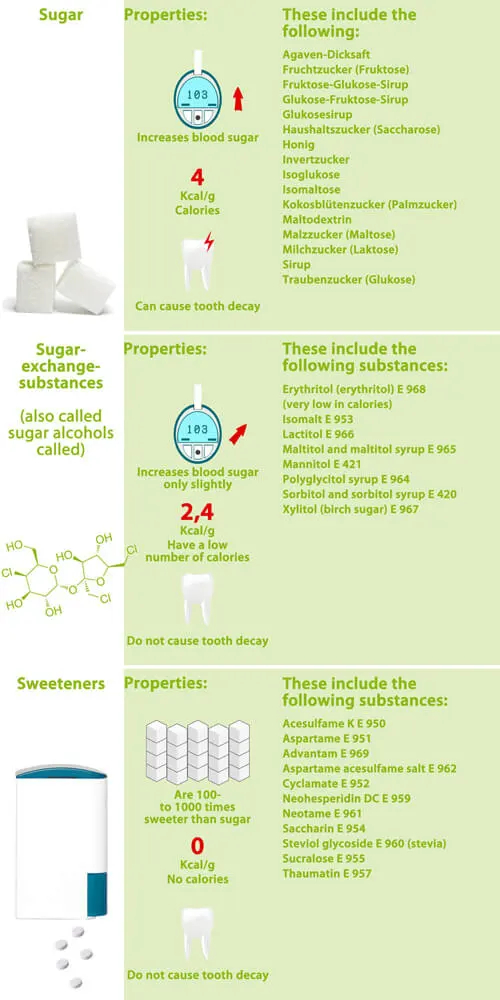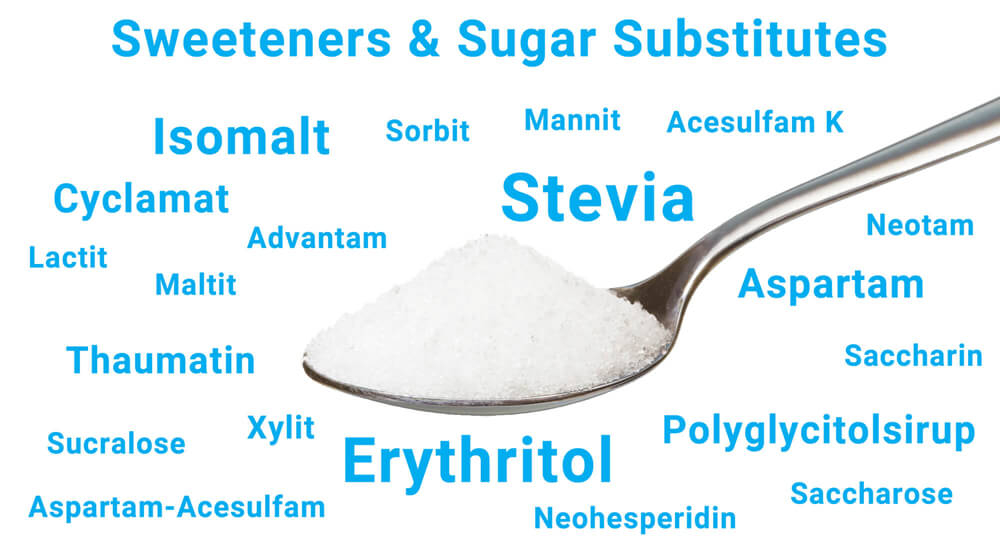Overview of sweeteners and sugar substitutes

The sugar substitute ABC | Facts about artificial sweeteners
More and more people are learning about the dangers of excessive sugar consumption and are looking for a healthier alternative. We can also see this trend in the growing market for sugar substitutes.
There are suitable options such as certain sugar alcohols and special sugars, as well as problematic sweeteners from the group of artificial sweeteners (such as Sucralose, Aspartame, Saccharin, Acesulfame-K and others). We have taken a closer look at the best-known sugar alternatives for you and present you with our little ABC of what you should look out for.
Would you like to give up sugar or reduce sugar? Here you can find out everything about sugar substitutes, their sweetening power and calories. It's not easy to keep track of all the different sweetener names in processed foods. Sugar substitutes and sweeteners: fitness gurus and nutritionists have different opinions when it comes to the health effects. In our sugar substitute ABC, we introduce sugar alternatives and what to look for in sweeteners and sugar substitutes.
Sugar substitutes can be used in many ways to replace sugar. They are metabolised without insulin, help to save calories and are tooth-friendly. The sweet-tasting compounds of sugar substitutes belong to the group of food additives. Sugar substitutes are divided into 2 groups: Sweeteners and sugar substitutes.
What can sweeteners do? Facts about artificial sweeteners
Synthetic sweeteners are also called artificial sweeteners. These synthetic sweeteners are permitted in Europe: Acesulfame potassium, Advantame, Aspartame, Acesulfame Aspartame salt, Cyclamate, Neohesperidin DC, Neotame, Saccharin, Sucralose and Thaumatin fall under artificial sweeteners and are different from natural sweeteners. Synthetically produced sweeteners have a sweetening power that is between 35 and 37,000 times stronger than sugar. Depending on the type of sweetener, they contain no calories or just as many calories as sugar. In terms of quantity, sweeteners need to be used much less because of their high sweetening power. Products sweetened with sweeteners therefore contain much fewer calories than products sweetened with sugar.
Synthetic sweeteners: Aspartame, Cyclamate, Saccharin, Sucralose...
However, the World Health Organisation (WHO) has set daily limits to minimise potential health risks. Artificial sweeteners are up to 37,000 times sweeter than sugar and are mainly used in industrially manufactured products because they are difficult to dose. In recent years, there has been much discussion about possible side effects. It is known that artificial sweeteners can have an unfavourable effect on the metabolism similar to sugar, especially Sucralose. This is probably due to breakdown products that can negatively affect the gut microbiome and make the intestinal wall more permeable to bacteria. Studies have also been conducted on DNA damage caused by Sucralose. The German Federal Institute for Risk Research (BfR) warns that "heating Sucralose may produce compounds that are harmful to health and carcinogenic". Further investigations are urgently needed.
Sucralose and Saccharin in wastewater
Sucralose is a sweetener that has about 600 times the sweetening power of sugar. Saccharin, on the other hand, is the oldest known artificial sweetener. Both sweeteners are often used in fitness products or diets. Neither in the body nor in sewage treatment plants are these sweeteners degraded in significant quantities, causing them to accumulate in the environment. Meanwhile, artificial sweeteners can be detected in all surface waters worldwide and their concentrations are continuously increasing. In our opinion, only biodegradable sweeteners should be used.
Not necessarily better: Fructose, honey, agave syrup and sugar beet syrup
Fructose occurs in small amounts (<10%) in all fruits. However, when dried fruits or fruit juices are consumed, a larger amount can quickly be ingested. In the food industry, Fructose, which is derived from corn starch, is often used as a cheap raw material.
Fructose is a natural sugar that also occurs in many fruits. It has a higher sweetening power than household sugar (sucrose), which is why a smaller amount is needed to achieve the same sweetness. Compared to sucrose, Fructose is about 1.4 times as sweet. By using Fructose instead of sucrose, the food industry can reduce the sugar content in products while maintaining the desired sweetness.
However, it is important to note that excessive consumption of Fructose can also have negative health effects, especially when consumed in large amounts from processed foods and beverages. High consumption of Fructose has been linked to problems such as weight gain, insulin resistance, fatty liver and increased risk of cardiovascular disease. Therefore, it is important to reduce the overall consumption of sugary products, whether they contain sucrose or Fructose.
In the lecture "Sugar: The bitter truth", the American paediatrician and endocrinologist Robert Lustig explains three main disadvantages of foods containing Fructose. First, Fructose suppresses the satiety hormone leptin, which can cause a persistent craving for food despite sufficient calorie intake. Secondly, Fructose is stored as fat in the liver as well as in the tissues. Many people have difficulty digesting large amounts of Fructose and this can lead to unpleasant symptoms such as flatulence and diarrhoea.
An overview of sugar alternatives:
Apple syrup, agave syrup, sugar beet syrup and other sweet syrups have a high sugar content. They have similar disadvantages to conventional sugar. Agave syrup in particular is especially sweet due to its high Fructose content. Although sugar beet syrup has a higher mineral content, it is hardly better than white sugar and has a distinctive taste of its own. Tip: If you use sugary sweeteners, it is advisable to be physically active afterwards. In moderation, they are acceptable before exercise, but less beneficial after.
An overview of sugar alternatives:
The most interesting sugar alcohols include Erythritol and Xylitol
There are different types of sugar alcohols such as maltitol, mannitol and sorbitol, all of which have a lower calorie content than sugar. Unlike sugar, sugar alcohols such as sorbitol, Xylitol and Erythritol have the advantage that they cannot be converted by caries bacteria (Streptococcus mutans) into acid that attacks the teeth. For this reason, they are often used in dental care products such as chewing gum or sweets. In addition, Xylitol and Erythritol also have the advantage that they do not have an unpleasant aftertaste. Made from renewable raw materials such as wood, corn plant fibres, Xylitol or Erythritol is made from corn starch without the use of genetic engineering.
What about in terms of calories? Xylitol has a 40 percent reduced calorie content compared to sugar, while Erythritol is even calorie-free. Products containing Erythritol and Xylitol cause a lower increase in blood sugar levels compared to sugary foods. This offers particular advantages for low-carb followers and people with diabetes, as the need for insulin is reduced.


Sugar substitutes: Allulose, Isomaltulose and Trehalose
In addition to sucrose (household sugar), which is widely used, there are several other types of sugar that largely do not have the disadvantages of sugar. These include: Allulose, Isomaltulose and Trehalose.
Allulose, similar to Erythritol, has no calories and is made from ordinary sugar. It has a sweetening power of about 60% of sugar. It can be widely used as a sugar substitute, although unfortunately it is not yet approved in the EU. The approval process for Allulose is currently underway. Allulose has been considered safe in the USA for several years and is gaining popularity. In fact, Trehalose and Allulose are two different sugars with different properties and uses.
What is Trehalose?
Trehalose is a naturally occurring sugar found in many organisms, including plants, animals and microorganisms. Chemically, it is a disaccharide consisting of two glucose molecules linked together by a special glycosidic bond.
Trehalose is known for its ability to protect cells and biomolecules. It is a stable sugar that helps maintain the structure and function of proteins, lipids and other biological molecules during dehydration or in extreme environments. These properties make Trehalose an interesting substance in various fields such as the food industry, pharmaceuticals, biotechnology and cosmetics.
In the food industry, Trehalose is often used as a sugar substitute and stabiliser. It can be used to improve the texture of food, retain moisture and extend shelf life. Trehalose is also marketed in some health products and supplements, although its health benefits need further research.
It is important to note that despite its many potential benefits, Trehalose cannot be broken down by all organisms. For example, humans lack an enzyme that can break down Trehalose into its individual glucose molecules. Therefore, Trehalose is not metabolised in the body and does not cause a rise in blood sugar levels like other sugars.
What is Isomaltulose?
Isomaltulose is a carbohydrate consisting of glucose and Fructose. Chemically, it is a disaccharide linked by a glycosidic bond between glucose and Fructose. Isomaltulose is also called Palatinose because it was first isolated from sucrose (table sugar).
The particular advantage of Isomaltulose is its special digestion and metabolism in the body. Unlike other types of sugar, Isomaltulose is broken down more slowly and absorbed more slowly in the intestine. As a result, it leads to a slower rise in blood glucose levels and contributes to a steadier flow of energy. This slow and steady flow of energy can help keep blood glucose levels more stable and provide energy over a longer period of time.
Isomaltulose has a similar sweet taste to sucrose but a lower glycaemic index. This means that it causes blood sugar levels to rise less than conventional sugar. It is therefore often used as an ingredient in foods that aim for a low glycaemic index, such as sports drinks, energy bars and diabetic products.
It is important to note that Isomaltulose still contains carbohydrates and should therefore be consumed in moderate amounts, especially for people with diabetes or other metabolic disorders. As with all food additives, it is advisable to follow the consumption recommendations and information on product labels.
More information about the individual sweeteners
Acesulfame K is a synthetic sweetener used as an additive in foods. It has a high sweetening power and is often combined with other sweeteners to improve taste. Acesulfame K is calorie-free and is not metabolised by the body, which makes it attractive for dietary and sugar-free products. It has good stability at high temperatures and can therefore be used for baking and cooking. Although it is considered safe for consumption, there is some controversy and concern about possible health effects.
Aspartame is an artificial sweetener used as a substitute for sugar in many foods and drinks. It is about 200 times sweeter than sugar. Aspartame is made up of the amino acids aspartic acid and phenylalanine. It is low in calories and has no effect on blood sugar levels. However, aspartame can be harmful to people with the rare metabolic disorder phenylketonuria (PKU).
Cyclamate is an artificial sweetener used as a flavour enhancer. It is about 30 to 50 times sweeter than sugar. It was first discovered in the 1930s and has since been approved as a food additive in many countries. Cyclamate has a slightly bitter aftertaste, which is why it is often combined with other sweeteners. It is controversial whether cyclamate has any health effects, and in some countries it is restricted or banned due to potential health risks.
Saccharin is an artificial sweetener used as a sugar alternative. It is about 200 to 700 times sweeter than sugar. Saccharin has no significant calories and is often used in low-calorie or sugar-free products such as drinks, desserts, sweets and chewing gum. It was first discovered in the late 19th century and has been approved as a food additive ever since. Although saccharin is considered safe for consumption, it can have a metallic aftertaste in some people.
Sucralose is an artificial sweetener that is about 600 times sweeter than sugar. It is made from sucrose (sugar) by replacing three hydroxyl groups with chlorine atoms. Sucralose has no significant calories and is often used in low-calorie or sugar-free foods and beverages. It has a similar taste to sugar without the bitter aftertaste of some other sweeteners. Sucralose is commonly used in diet colas, energy drinks, juices, alcoholic beverages, teas, yogurts, puddings, pastries, frozen desserts, canned fruits, chewing gums, protein powders, candies and cereals.
Effects on the gut: The use of sucralose can lead to a reduction in the diversity of gut bacteria and damage beneficial gut bacteria. These damaged bacteria can even enter the bloodstream through the compromised intestinal lining, which is not ideal. Influence on blood sugar levels: Even at levels considered safe, sucralose can influence blood sugar levels. After only two weeks, participants were found to have a poor utilisation of sugar, which led to massively increased blood sugar levels.
Thaumatin is a naturally occurring protein that is used as a sweetener. It is extracted from the fruit of the West African katemfe plant. Thaumatin has a very high sweetening power, about 2,000 to 3,000 times stronger than sugar. It is often used in foods and beverages to improve taste and reduce the need for sugar. Thaumatin has a long-lasting, mild sweet taste and is often combined with other sweeteners to achieve the desired taste. It is classified as safe for consumption and many countries have approved thaumatin as a food additive.
Stevia, or more precisely steviol glycosides, is a natural sweetener extracted from the leaves of the stevia plant. It is significantly sweeter than sugar and has no significant calories, making it a popular alternative for people who want to reduce their sugar intake. Steviol glycosides do not affect blood sugar levels, which may make them suitable for diabetics. They are also tooth-friendly as they are not broken down by bacteria in the mouth. Stevia is considered safe for consumption and many countries have approved it as a food additive.
Neotame is a high-intensity artificial sweetener chemically related to aspartame. It is approximately 8,000 to 13,000 times sweeter than sugar. Neotame was developed to provide an intense sweet taste while having no bitter aftertastes. It has high stability at high temperatures and a wide pH range, making it suitable for various food and beverage applications. Neotame has no significant nutritional value and does not affect blood sugar levels. It has been deemed safe for consumption by the US Food and Drug Administration (FDA).
Neohesperidin DC is a natural plant compound derived from the citrus fruit bitter orange (Citrus aurantium). It belongs to the group of flavonoid glycosides. Neohesperidin DC is often used as a flavour enhancer and bittering agent to improve the taste of foods and beverages. It has a pronounced bitterness, which is why it is often used in combination with other sweeteners to achieve a balanced taste. Neohesperidin DC has a low calorie count and does not affect blood sugar levels. It is approved as a food additive and is considered safe for consumption.
Aspartame acesulfame salt is a mixture of the artificial sweeteners aspartame and acesulfame-K. This combination is often used to give a sweet taste. This combination is often used to provide improved sweetness and a more balanced taste. It is about 200 to 300 times sweeter than sugar. Aspartame-acesulfame salt is often used in low-calorie or sugar-free foods and beverages to reduce sugar content without sacrificing sweet taste. It has high stability under heat and is therefore suitable for a wide range of applications. It is approved as a food additive and is considered safe for consumption.
Advantam is a high intensity artificial sweetener that is approximately 20,000 times sweeter than sugar. It was developed to provide very high sweetness while providing a pleasant taste without a bitter aftertaste. Advantam is approved as a food additive for use in foods and beverages in many countries. It has no effect on blood sugar levels and contains no calories. Advantam has high stability under heat and a wide range of pH values, making it suitable for various food and beverage applications. It is considered safe for consumption.

 German
German Dutch
Dutch French
French Italian
Italian Portuguese
Portuguese Spanish
Spanish

